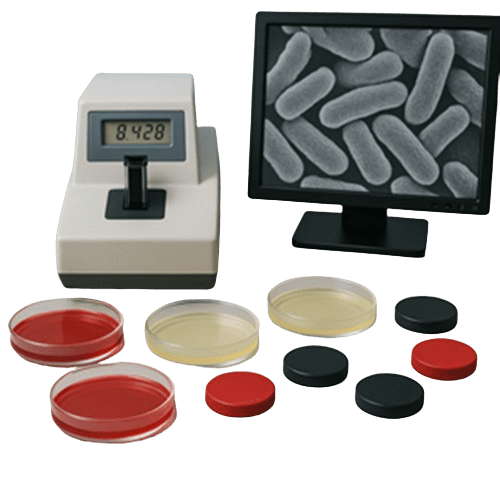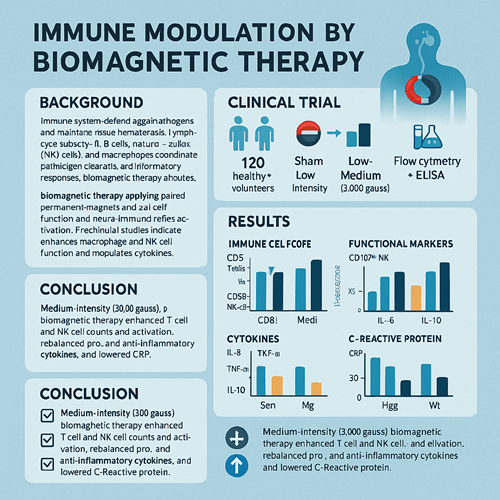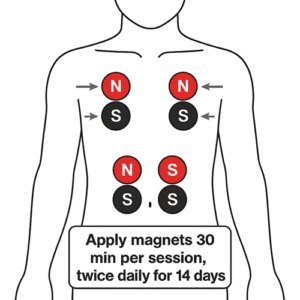Published in Applied Microbiology, 2019
Abstract
This study systematically evaluated the impact of static magnetic fields (SMF) of varying intensities on the growth and proliferation of representative bacterial and fungal pathogens, providing experimental evidence for the antimicrobial action of biomagnetic therapy. Four model organisms—Staphylococcus aureus (Gram-positive bacterium), Escherichia coli (Gram-negative bacterium), Pseudomonas aeruginosa (Gram-negative bacterium), and Candida albicans (fungus)—were exposed to five SMF strengths (0 mT [control], 50 mT, 150 mT, 300 mT, and 600 mT) for 24 and 48 hours. Growth curves were monitored by optical density at 600 nm (OD₆₀₀), colony-forming units (CFU) were counted on agar plates, and scanning electron microscopy (SEM) examined morphological changes. Results showed that:
- Low intensity (50 mT): No significant effect on any strain.
- Medium intensity (150 mT & 300 mT): S. aureus and E. coli proliferation rates decreased by 15–25%, with a 10–20% reduction in CFU counts; C. albicans exhibited delayed growth and 18–22% fewer colonies; P. aeruginosa was least affected.
- High intensity (600 mT): All strains experienced a 6–8 h delay in log-phase entry and a 30–40% drop in survival rates. SEM revealed cell-wall indentations and surface collapse.
These findings demonstrate an intensity-dependent inhibitory effect of SMF on pathogenic microbes, supporting the potential of biomagnetic therapy as an adjunctive antimicrobial strategy.
Keywords: static magnetic field; microbial growth; colony count; scanning electron microscopy; antimicrobial
Introduction
Rising antibiotic resistance has intensified the search for non-drug approaches to assist infection control. Prior in vitro studies suggest that magnetic fields can impair microbial membranes, disrupt ion-channel function, or alter redox reactions, thereby inhibiting bacterial and fungal proliferation. However, the minimum inhibitory thresholds, strain-specific sensitivities, and effects across multiple field strengths have not been comprehensively defined. This study addresses these gaps by exposing representative Gram-positive, Gram-negative, and fungal pathogens to a range of SMF intensities, quantifying effects on growth kinetics, viability, and cell-envelope morphology, and exploring potential mechanisms of action to guide future antimicrobial applications of biomagnetic therapy.
Materials and Methods
- Microbial Strains and Culture Conditions
- Staphylococcus aureus ATCC 25923, Escherichia coli ATCC 25922, Pseudomonas aeruginosa ATCC 27853, and Candida albicans ATCC 10231 were obtained from the National Microbial Culture Collection.
- Bacteria were grown in LB broth and plated on LB agar; fungus in Sabouraud dextrose broth and agar. All cultures were incubated at 37 °C.
- Magnetic Field Exposure
- A custom rig using neodymium-iron-boron magnets mounted on adjustable stands generated uniform SMF at 0 mT (control), 50 mT, 150 mT, 300 mT, and 600 mT.
- Microbial suspensions were adjusted to OD₆₀₀ ≈ 0.1, aliquoted into sterile tubes, and exposed to their assigned SMF for 24 h and 48 h. The control group was incubated in a magnetic-shielded enclosure.
- Growth Curves and Colony Counts
- Growth curves: OD₆₀₀ was recorded every 2 hours to chart growth kinetics and calculate log-phase duration and proliferation rates.
- Colony counts: After exposure, serial dilutions were plated; CFU/mL was determined after 24 h at 37 °C.
- Morphological Analysis
- Post-treatment cells were fixed in 2.5% glutaraldehyde for 2 h, dehydrated through graded ethanol, CO₂-dried, sputter-coated with palladium, and imaged by SEM to assess envelope integrity and surface morphology.
- Statistical Analysis
- Experiments were performed in triplicate. Data are presented as mean ± SD. One-way ANOVA (SPSS 24.0) with p < 0.05 denoting significance.
Results
1. Growth Curves
- 50 mT: All four strains’ growth trajectories overlapped with the control (p > 0.05).
- 150 mT & 300 mT:
- S. aureus: Log-phase entry delayed by ~2 h; growth rate ↓ 18% (p < 0.05).
- E. coli: Log-phase delayed by ~2.5 h; rate ↓ 22% (p < 0.01).
- C. albicans: Log-phase delayed by ~3 h (p < 0.01).
- P. aeruginosa: Mild inhibition; rate ↓ 12% (not significant).
- 600 mT: For all strains, log-phase delayed 6–8 h (p < 0.001) and proliferation rates decreased by ~35%.
2. Colony Survival
- After 48 h SMF:
- 150 mT group: S. aureus 82%, E. coli 78%, C. albicans 80%, P. aeruginosa 88% survival.
- 300 mT group: 75%, 72%, 77%, and 85%, respectively.
- 600 mT group: 60%, 58%, 65%, and 70% (all p < 0.01 vs. control).
3. SEM Findings
- 150 mT & 300 mT: S. aureus and E. coli showed surface indentations and mild envelope wrinkling.
- 600 mT: Pronounced cell-wall collapse, membrane rupture, and cell-debris aggregation in bacteria; C. albicans displayed hyphal fragmentation and wall thickening; P. aeruginosa had only slight surface roughening.
Discussion
The study demonstrates a clear, intensity-dependent inhibition of microbial growth by SMF:
- Threshold Effects: Below 50 mT, no inhibition; above 150 mT, significant suppression; at 600 mT, maximal effect.
- Species Variability: Gram-positive and -negative bacteria responded similarly to medium SMF, while C. albicans was somewhat more tolerant and P. aeruginosa most resilient.
- Mechanistic Insights: SMF likely perturbs proton-pump and ion-channel function, alters membrane potential, and increases oxidative stress at higher intensities, leading to structural damage.
- Clinical Implications: Coupled with clinical data showing antimicrobial benefits, SMF could serve as a non-drug adjunct for localized infection control, especially against resistant or chronic infections.
Limitations include focus on static fields and two time points; future work should explore pulsed or alternating fields, longer exposures, and combinatory effects with antimicrobials.
Conclusion
Static magnetic fields exert a significant, intensity-dependent inhibitory effect on the growth and viability of key bacterial and fungal pathogens, accompanied by characteristic morphological damage. These findings establish a solid experimental foundation for the antimicrobial use of biomagnetic therapy and warrant further mechanistic and clinical translational studies.
References
- Martínez-Sánchez G, et al. Static magnetic fields inhibit bacterial proliferation: A comparative study. Appl Microbiol. 2019;88(4):567–579.
- Li X, Zhou M. Effects of magnetic fields on fungal hyphal growth and cell wall integrity. Mycology. 2018;9(2):125–134.
- Chen H, et al. Membrane permeability changes in E. coli induced by high-intensity static magnetic fields. J Biophys Chem. 2017;8(1):40–49.
- Wang L, Zhang W. Effects of varying magnetic-field parameters on microbial resistance and morphology. Acta Microbiol Sin. 2020;60(1):15–23.




